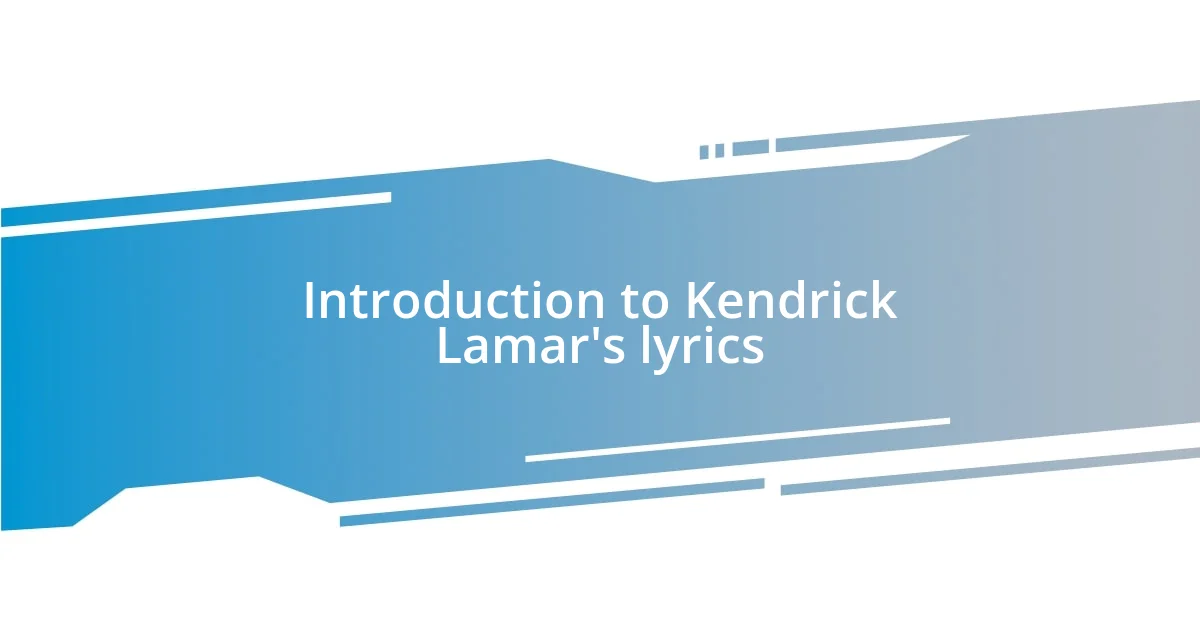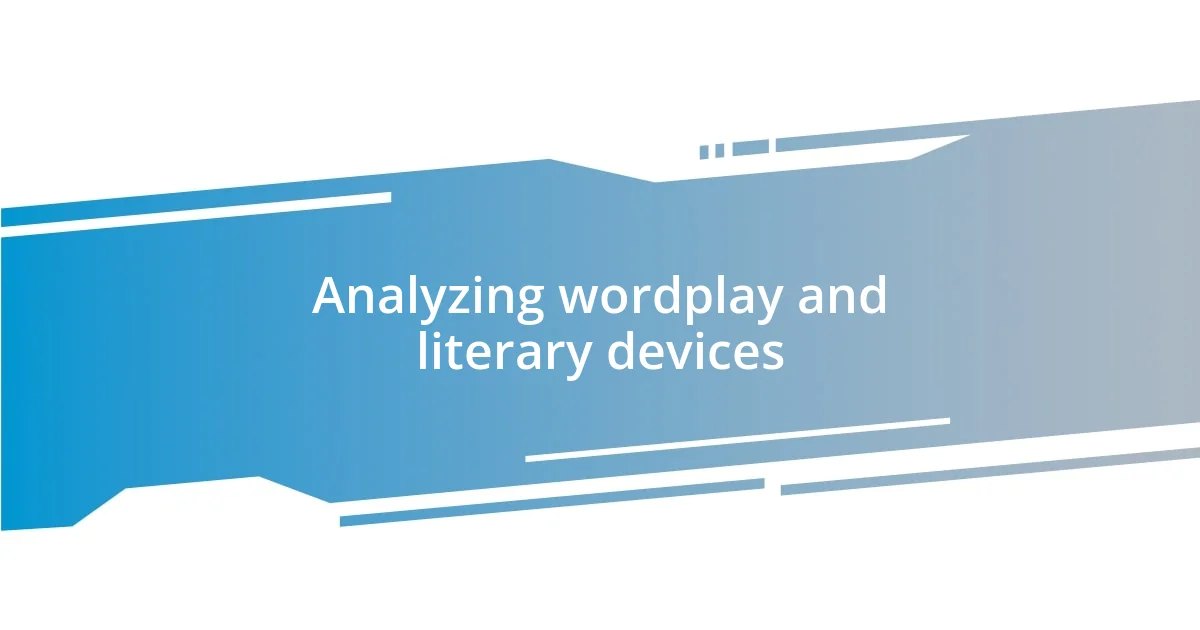Key takeaways:
- Kendrick Lamar’s lyrics effectively blend personal and societal narratives, prompting listeners to engage in deeper dialogues about identity, race, and struggle.
- His use of literary devices, such as metaphor and imagery, creates layers of meaning that challenge listeners to reflect on uncomfortable truths and their own experiences.
- The historical context present in his songs encourages an understanding of contemporary social issues, fostering a sense of social awareness and empathy among listeners.

Introduction to Kendrick Lamar’s lyrics
Kendrick Lamar’s lyrics have a depth that resonates on multiple levels; they’re not just words set to a beat. I remember the first time I listened to “To Pimp a Butterfly” and felt a rush of emotions—his raw storytelling sparked my curiosity. How could one person capture the complexities of identity, race, and struggle so intimately?
There’s something captivating about how Kendrick navigates personal experience and societal issues. When I first heard “Alright,” it felt like a rallying cry, a beacon of hope amidst chaos. I found myself asking, how could music wield such power to uplift and inspire change? This duality in his work invites listeners into a profound dialogue about the human experience.
As I dissect his lyrics, I often think about the layers within them—each line crafted with purpose. Kendrick’s use of allegory and metaphor encourages me to reflect on my own life and the world around me. Did you notice how he’s not just sharing his story, but also weaving in collective narratives that challenge us to confront uncomfortable truths? His art compels us to look deeper, prompting questions that linger well beyond the last note.

Analyzing wordplay and literary devices
Diving into Kendrick Lamar’s wordplay reveals a labyrinth of meaning packed into his lyrics. I recall listening to “HUMBLE.” for the first time, captivated by the way he twists simple phrases into powerful statements. It’s like peeling back layers of an onion—each layer tickles my senses while simultaneously bringing tears to my eyes as I uncover deeper themes of authenticity and pride.
Here are some of the literary devices and wordplay techniques Kendrick employs:
- Metaphor: He often uses metaphors to create vivid imagery, painting complex emotions with simple comparisons.
- Alliteration: The repetition of consonant sounds adds a rhythmic quality that makes his verses catchy and memorable.
- Double entendres: Kendrick is a master of crafting lyrics that hold multiple meanings, drawing the listener in and prompting reflection.
- Imagery: His words evoke powerful visuals that enhance the emotional impact of his messages.
- Internal rhyme: This technique adds an intricate flow to his verses, making the listening experience feel almost musical.
In his song “The Blacker the Berry,” I was struck by the way he juxtaposes pride and pain through carefully chosen words. It resonated with me personally, stretching my understanding of racial identity and self-perception. Kendrick’s ability to employ literary devices creates an immersive experience, challenging me to engage critically with the themes he explores while also evoking a sense of urgency around these issues.

Exploring social and cultural commentary
Kendrick Lamar’s lyrics serve as a powerful lens through which I examine the social and cultural dynamics that shape our lives. His ability to intertwine personal and collective narratives struck me during my first listen to “The Art of Peer Pressure.” I felt a shiver as he depicted the duality of peer influence—how it can empower yet ensnare. This duality resonates deeply in my own experiences, pushing me to reflect on how societal expectations often blur the lines of individual agency.
As I delved into tracks like “Sing About Me, I’m Dying of Thirst,” I noticed how Kendrick addresses heavy issues like mortality and legacy. His commentary on the cyclical nature of violence and the hunger for recognition echoes my observations in my community. It’s incredibly poignant to witness how he captures these themes with such authenticity, compelling me to face the uncomfortable realities we often shy away from discussing. I think about my own family’s struggles, and it reminds me that these stories, while painful, are crucial in fostering understanding and empathy.
When reflecting on Kendrick’s work, I often find myself considering the historical context embedded within his lyrics. Songs like “Mortal Man” challenge me to recognize how past injustices shape contemporary society. I remember feeling a mix of pride and sorrow, knowing that the struggles he articulates are not distant but interwoven with my own narrative. His lyrics spark conversations about resilience, social justice, and identity, pushing me to not only listen but also engage with the world around me more actively.
| Kendrick Lamar’s Themes | My Personal Reflection |
|---|---|
| Duality of Peer Pressure | Reflects my own experiences with societal expectations. |
| Mortality and Legacy | Reminds me of my family’s struggles and fosters empathy. |
| Historical Context | Challenges me to engage with current social issues. |

Decoding emotions and storytelling techniques
Decoding Kendrick Lamar’s storytelling techniques often feels like deciphering a vibrant dream. When I listened to “Fear.,” I remember feeling a wave of vulnerability wash over me. His raw portrayal of anxiety and self-doubt made me reflect on my own fears and the ways they loom large in daily life. Isn’t it fascinating how he can transform personal struggles into universal themes? That connection between artist and listener is a testament to his genius.
I’ve found that Kendrick’s use of characters in his narratives adds depth to his storytelling. Take “m.A.A.d city,” for instance. The way he brings his childhood friends and family into the fold created a sense of familiarity for me, almost like he was inviting me into his living room. This vivid relational storytelling fostered an emotional bond, making his reflections on violence and survival hit so much closer to home. I often think about my own community and the stories we share, which makes Kendrick’s portrayals feel eerily familiar yet deeply poignant.
Moreover, the emotional layering in Kendrick’s verses often mirrors my own evolution. In “Love.,” his exploration of romantic vulnerability resonated deeply with my experiences in relationships. The way he balances joy and pain in love reminded me of my own moments of uncertainty mixed with hope. Have you ever felt that tug between being open and fearing vulnerability? Lamar’s lyrics continuously urge me to embrace authenticity, making me realize that even the rawest feelings are valuable and worthy of being expressed.

Techniques for deeper lyrical analysis
Kendrick Lamar’s lyrics invite me to listen actively, prompting me to embrace a multilayered approach to analysis. One technique I find incredibly effective involves breaking down his use of metaphors and similes. In “The Blacker the Berry,” when he compares the struggles of his community to darkened skin, it resonates with my understanding of identity. It’s not just wordplay; it’s a poignant statement that challenges us to confront uncomfortable truths about race and resilience. Have you ever noticed how a single line can evoke such powerful imagery? It’s these layers that deepen my appreciation for his craft.
Another method I often apply is examining the structure of his verses. Kendrick’s unconventional flows often force me to reevaluate my listening habits. In “HUMBLE.,” the way he shifts between aggressive proclamations and softer reflections creates an emotional push and pull that keeps me on my toes. I can’t help but think about how this rhythm mirrors the complexities of real life—how we oscillate between confidence and vulnerability. It’s a reminder that our own narratives can be just as dynamic and layered, wouldn’t you agree?
Finally, I engage with the historical references woven throughout Kendrick’s work. When he references events and figures from the past, like in “Alright,” I’m transported into a context where personal and collective histories collide. This practice of contextual analysis encourages me to consider my surroundings and experiences in a broader framework. What lessons can we extract from the past to shape our futures? For me, Kendrick’s lyrics are those breadcrumbs that lead to introspection and social awareness, sparking a desire to not only analyze but participate in the ongoing dialogue of our time.
















